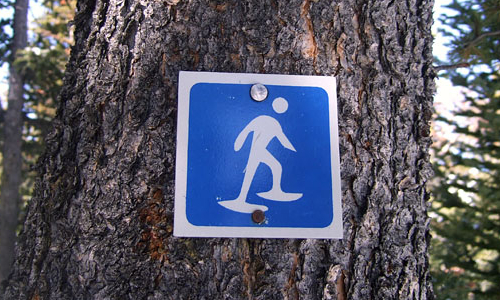Getting started with snowshoes

Snowshoeing is probably the easiest snow sport to learn, and can be enjoyed by people of all ages and abilities. Participants can take a leisurely walk through the park, explore some remote backcountry or pick up the pace and jog for a great winter workout. Because the snow acts like a cushion, snowshoeing provides an excellent low impact workout. Casual walking in snowshoes burns approximately 500 calories per hour while jogging can expend nearly 1000.
Snowshoes are designed to provide flotation, traction and stability in the snow. Flotation is the result of an increased surface area underneath your boot and the distribution of your body weight across the snow's surface. Factors that affect the amount of flotation include snowshoe (surface area) size, total body weight and snow conditions. A larger snowshoe size will provide greater flotation, but the tradeoff is less maneuverability and greater weight. Snow density also determines the amount of flotation a snowshoer will experience. Heavy, wet or packed snow will provide much more support than a fresh dry powder. Although snowshoes give you increased flotation, they will sink down into the snow a few inches or more depending on the above mentioned conditions.
The key to an enjoyable snowshoe outing is being comfortable and warm while in the outdoor environment. Layering your clothing provides for easy adjustment during varying conditions and activity levels. The first layer should be lightweight and breathable, the ability to pull moisture away from the skin. The second layer provides the insulation, which can be matched to the outside temperature. The final or outer layer protects from the wind and wet snow. The same principles apply to your feet. A thin lightweight liner sock should be worn first with a heavier wool or hiking sock over the top. Waterproof boots or shoes are recommended to keep your feet warm and dry.
Lacing up the snowshoe is the first step to a fun and safe winter hike. One of the keys to a proper fit is to have the toe and heel straps adequately tightened to avoid unwanted foot movement during walking. If the snowshoe style is symmetrical or there is no discernible way to tell the left from the right, place the shoes on your feet with the buckles or tightening straps to the outside. Position your foot in the binding with the ball of your foot placed far enough forward so that it is centered over the toe strap. Tighten the toe strap to a firm and snug fit being careful not to tighten so much that circulation is hampered. Next place the heel of your boot in the center of the snowshoe deck and pull the heel strap tight against your foot. Finally tighten the ankle or remaining foot straps and tuck any loose strap ends under the ankle or heel strap and you are ready to begin your winter adventure.
First time snowshoers will want to familiarize themselves with the feel and stride of snowshoeing by starting out on a flat horizontal surface. Packed trails provide an excellent first run on snowshoes until you feel comfortable and stable with the feel and gait of the snowshoe stride. Upon quickly mastering horizontal terrain you are ready to access the beauty of nature and tackle all that the sport has to offer. Not only will you be having fun, but you will also be improving your health and fitness level while losing weight and gaining strength.
Credits - WorldwideRunning.com would like to thank the Glacier Snowshoe Company (www.glaciersnowshoe.com) for the authorization to partially reprint the article "Snowshoeing Tips".

